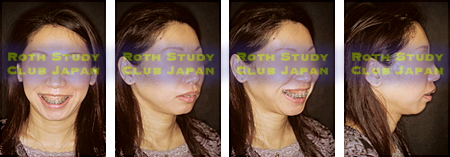Orthognathic Surgery
When skeletal discrepancies are so severe that a good occlusion cannot be obtained with orthodontics alone, jaw relationship can be corrected with orthognathic surgery. When we find significant mandibular deviation at the time of initial examination or after splint therapy, we present a surgical treatment plan to the patient. Because orthognathic surgery produces dramatic changes in not only occlusal relationship but facial profile, post-surgical facial changes are simulate the treatment planning process. Surgical movement of the jaw bones and orthodontic movement of the teeth are studied carefully to optimize facial appearance. If the initial non-surgical plan does not work, the orthodontist may have to switch to a surgical alternative in the middle of treatment. In such a case, teeth have to be moved in entirely different ways, and even then end results would not be as satisfactory.
Before orthognathic surgery

The chin is severely retruded and the upper jaw or maxilla is protruded with excessive display of the gums below the upper lip.
After orthognathic surgery

The maxilla was split and impacted and the mandible was advanced. The chin was brought forward with genioplasty. A relaxed and natural facial profile was obtained.
